Real Danish Food: Nørrebro’s Little Smørrebrød Shop
Authentic Danish food is the Sasquatch of the Euro-Scandinavian culinary scene. There’s Noma of course, as well as a small army of Michelin Star restaurants but talking about them as authentic outlets for Danish food is a bit like talking about a brand new Bentley as a solid, reliable, every-day car for the average Joe. For the typical traveler, resident, and student battling the grumblings of an empty stomach dropping $300 on a meal – even if it is allegedly the best meal in the world – isn’t an option or real interest for most of us.
I enjoy a fancy meal as much as the next guy, but my definition of a real, authentic meal? A small hole-in-the-wall with barely enough room to eat your meal, hearty portions and a dirt cheap price that comes with an over abundance of character and flavor. My favorite types of eateries are the ones that are good enough, and priced reasonably enough that you go back time and time again. The best places? The type you go back to so often that the staff starts to recognize you and knows your order by heart.
While Copenhagen has a lot of great hole-in-the-wall eateries most are small salad, kebab, or burger shops. When I first arrived in Denmark I was eager to figure out A) what Danish food was and B) where I could get it. I posed what I thought was a straightforward question to the Danes I met: What do I order and where do I get it? Their answer: Smørrebrød. Invariably what followed was a soft silence. I’d look on, waiting, expecting a long list of local delicacies and unique Scandinavian seafoods and meat dishes. The silence would stretch from natural pause to slightly awkward before I’d take the hint and accept that smørrebrød was the totality of their answer.
Ask a Dane where to find smørrebrød and you’ll usually see the shadow of a thoughtful frown flash across their face followed by an “ohhhh, hmmm”. It turns out that while smørrebrød may be the most Danish dish out there, Danes don’t usually buy it. Instead they make it in their homes or eat it in cafeterias at work. Outside of semi-authentic, over priced smørrebrød served up in tourist cafes along Nyhavn, chasing down authentic smørrebrød is a difficult challenge.
Slightly vexed, I’d press my Danish friends for other suggestions. After all, Denmark has to have more than just smørrebrød to offer, right?
Perhaps you can imagine the slapping sound of my facepalm at what inevitably came next. When pressed, I’ve had many-a-Dane tell me hot dogs. Yes. Hot dogs. To be fair, Denmark does have a prolific number of hot dog stands with a wide assortment of hot dogs, sausages, and bøfsandwiches. They’re also quite good as far as hot dogs go. Not Washington D.C.’s Ben’s Chili Bowl good mind you, but still, better than your average dog. Now, perhaps i’m putting words into your mouth, but I’m going to guess that no matter how good the hot dog, most of us didn’t travel hundreds, perhaps thousands, of miles for a slightly sexed up hot dog.
So, this leaves us with what…Noma, hot dogs, and smørrebrød?
What is smørrebrød?
Smørrebrød is a mixture between a salad, a sandwich, and what an OCD person would assemble at an all-you-can-eat buffet. While inaccurately called open-faced sandwiches, smørrebrød consists of a piece of dark rugbrød (another Danish specialty) with a mixture of artfully layered toppings. These vary widely and can include everything from fish eggs and fish fillets, to sliced lunch meat, to pickled beets and even curried herring. Most include some sort of sauce, with the delicious Danish specialty remoulade being a regular favorite. Each is then topped by a fresh garnish which ranges from thin lemon and bell pepper slices to tomatoes, shrimp or green onions. A meal typically consists of several pieces of smørrebrød at once. I find that four to six is about right for me depending on my appetite.
Smørrebrød is good. Not just good. It is delicious. It’s also incredibly diverse. My favorite smørrebrød shop offers more than 80 different types of smørrebrød on its menu and for those who decide to make their own…the variations are limited only by your creativity, your taste buds and the size of your rugbrød.
Where to get authentic Smørrebrød in Copenhagen
For budget and authenticity minded visitors to Copenhagen, one of the best and most convenient locations for smørrebrød is Rita’s Smørrebrød (Ritas.dk), which is situated at #11, Fælledvej in Nørrebro. The shop is just north of the lakes and about an 8 minute walk from Norreport station. It’s closed on weekends, and is open between 7AM and 2PM.
Rita’s is authentic. It is intelligently priced. It is hugely popular with locals. It is a small hole in the wall. It is also one of the best spots in central Copenhagen for finding Danish food.
As I write this post I just got back from snagging lunch at Rita’s. By the time I got there it was already 12:30PM and as you can see, most of the day’s standard offerings were already snatched up. Rita’s offers a basic menu which includes some 40 or so “regular” smørrebrød offerings. They’re made fresh every day and displayed in an easy to view refrigerated counter so you don’t have to worry about braving obscure Danish words while ordering blindly from the menu. Just pick, point, eat and enjoy.
Smørrebrød on the regular menu cost 12 DKK a piece, or about $2.25 USD. To put that into context, a large Big Mac meal at McDonalds will run you ~60 DKK. They also have a “deluxe smørrebrød” menu which ranges in cost and has specialties such as their #86 which includes fried fish fillets, small shrimp, caviar, and asparagus on rugbrød. The folks at the counter speak English and have always been incredibly friendly, helpful, and happy to explain what I’m ordering.
Perhaps one reason Danes have such a hard time identifying and talking about traditional and authentic Danish foods is because most of the traditional Danish eats get incorporated into smørrebrød. You can find smørrebrød with leverpostej (liver pate), fried fish, herring, and what is in effect the Danish national dish – Frikadelle. Rita’s also offers a mixture of other traditional meats by themselves including friend fish fillets, traditional roast pork, frikadelle, and krebinet.
Today’s meal cost 48 DKK for four pieces of regular smørrebrød and another 14 DKK for a bottle of water. It was fresh, packed with flavor, mostly healthy, and extremely convenient. I decided to use one of the small shop’s two stools and ate there, but I usually grab my smørrebrød to go. With Rita’s close proximity to the lakes, it is the perfect place to pick up a little picnic lunch. They have their full menu online and a full English translation available so feel free to check it out – Ritas.dk.
I’ve also had Danish friends recommend Lene’s smørrebrød at Nordre Frihavnsgade 63 in Østerbro but have yet to try it. If you find you way to Rita’s during your next visit to Copenhagen, make sure to let me know what you think of the experience!
Happy eating!
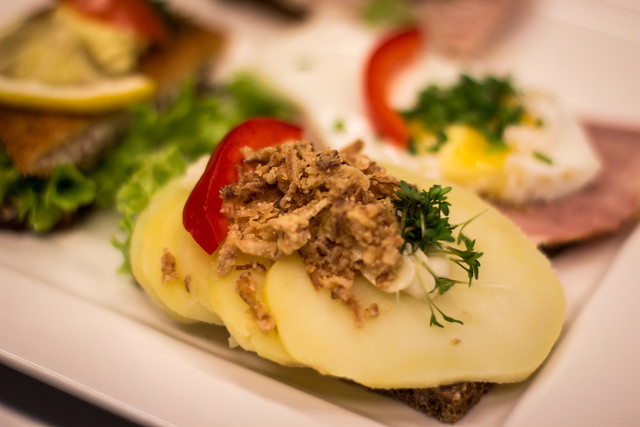
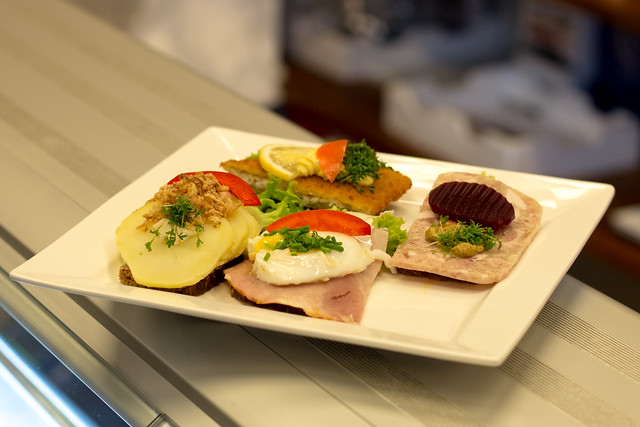
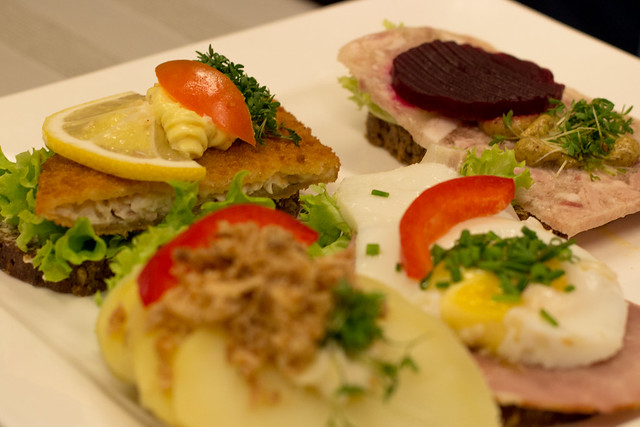
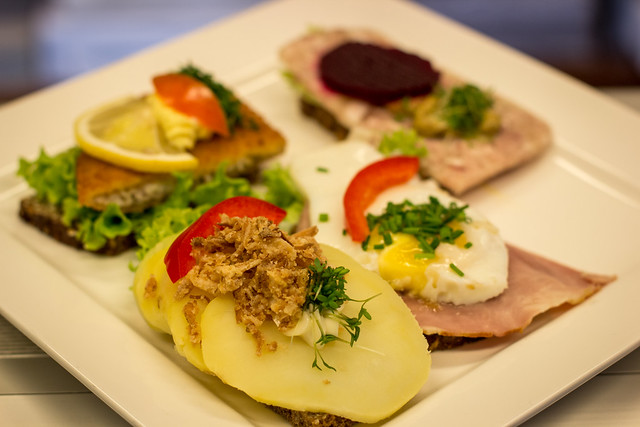
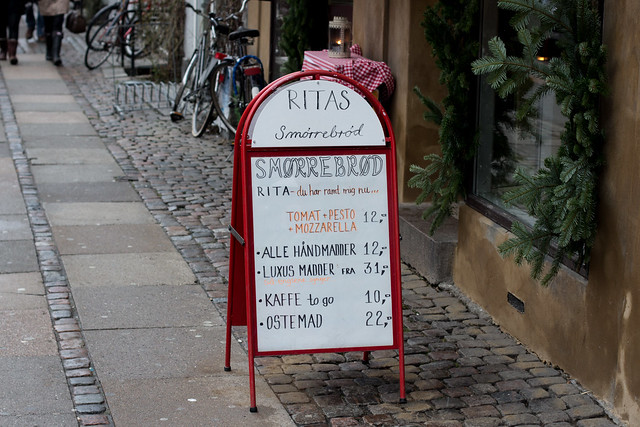
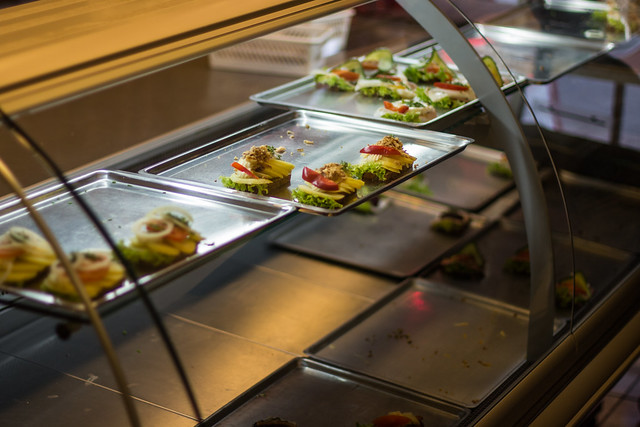
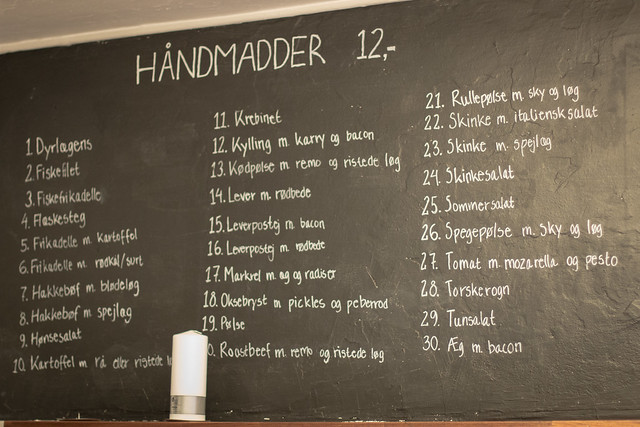
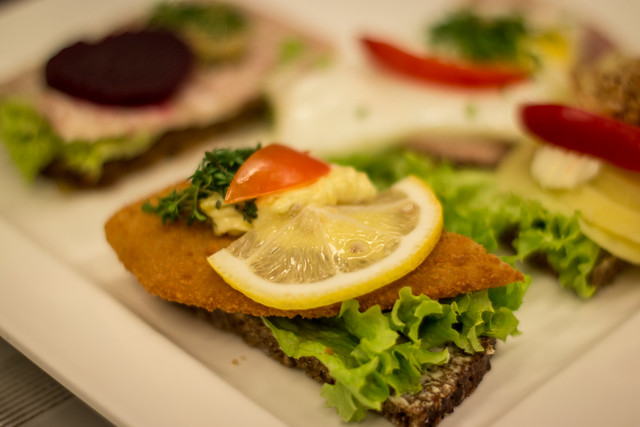
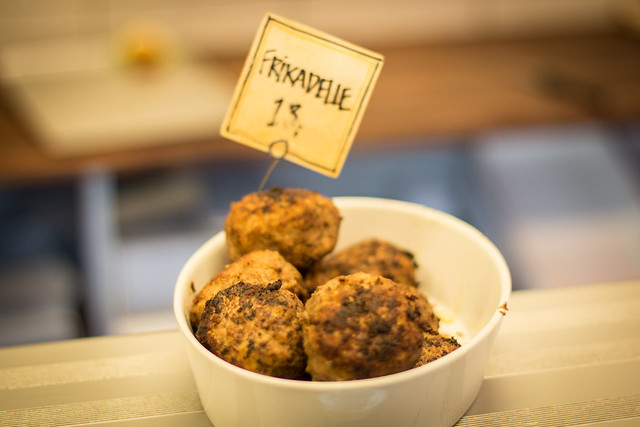
Oh, YUM. This looks amazing – i’d TOTALLY eat this all the time. delish!
It’s definitely tasty!
I wonder what the origin was? It occured to me that it’s not unlike tapas, small portions, so you can make a meal of different dishes and have a variety of tastes. Then I realized that tapas weren’t originally a meal, although lots of foreigners make a meal of them a well a some Spaniards these days.
Good question! Not sure. It might be that these pre-dated the modern sandwich, which only later added a second piece of bread to keep the whole thing more tidy and filling. The Danish Rugbrod is extremely hearty and not something you find outside of the Nordics. I think they also used a lot of fish in the original versions. So perhaps it’s old sailing fare?
Great advice. This is one of the few blogs I could find that recommended a local smørrebrød shop. My girlfriend and I tried it yesterday and loved it. Thanks for pointing this one out!
Great to hear James! Glad it was a help and thank you so much for the comment and letting me know! Enjoy Copenhagen!
As with most things in Denmark, smørrebrød originated with the farmers and not the city slickers in Copenhagen.
Leftovers from the day before and whatever was in the pantry would be brought out into the field at noon and it would be put together on the spot – bread, butter and toppings…
You would wash it down with a local beer and/or some local milk – maybe some brændevin, if you were lucky.
http://www.idadavidsen.dk is supposed to be THE place for smørrebrød in Copenhagen.
PS: Love your writeups on Denmark. It’s always interesting to get a foreigners perspective. You really need to get away from the capitol a little more often, though. Copenhagen is NOT Denmark.
I always hear about Ida Davidsen’s but when I looked into it their stuff seemed a bit pricey. At some point I do need to swing by and give it a go. Fun story behind the place. It probably doesn’t help that refuse to pay more than 15 DKK per piece.
Getting out of Copenhagen is always high on the list. Unfortunately, it has only been Aarhus and Aalborg. It is a bit of a problem that a ticket to get to Jutland usually costs more than a flight to Milan. I’ve also been in country now for more than a year, and the Danish Government has a silly law in place that says if I want to drive in DK I have to file for, pay for, and take the Danish driving exams. The good news is I’ve got a roadtrip with family planned for next week which will include Skane and more traditional Danish small towns across all of Denmark. Someone needs to convince the rest of DK’s local tourism boards to invite me out for a look
At the same time, most of my content will remain Copenhagen specific because, as much as I know many of you guys hate it, Copenhagen really is the primary part of DK 98% of visitors will see and interact with.
Tourism turnover in copenhagen is roughly 22% of Denmark’s tourism turnover. The people who visit Copenhagen probably spend more money than those who visit the rest of the country, so if you look at number of tourists, Copenhagen probably gets around 15%.
http://www.visitdenmark.dk/sites/default/files/vdk_images/PDF-and-other-files/Analyser/2014/turismen_i_danmark.pdf
The really interesting thing is how much of the state funds are spend in Copenhagen compared to the amount of tourism they generate / people who live there. I meen, that’s probably where you get your 98% from
We all pay taxes and we all get free education and free healthcare. However, higher education and proper healtcare is really only available in the big cities. Culture is heavily subsidised in Denmark – guess where the large majority of ‘culture’ is available?
As you said yourself, traveling across country costs the same as going to Milan. I live in Odense and see Copenhagen once every 5-10 years at max. The bridge alone costs 400,- DKK.
This is obviously not your fault, but It should be interesting for you to study who’s paying for all the fun in Copenhagen.
Copenhagen was broke in the 1970’s – Do you know who paid for that?
Now that Copenhagen is back on its feet, all they can say is: ‘If we just spend a little more tax money in Copenhagen, the whole country will prosper’. Not really.
Rant over
Enjoy your time in the Danish heartland (that includes Skåne for those of us with an interest in history)…